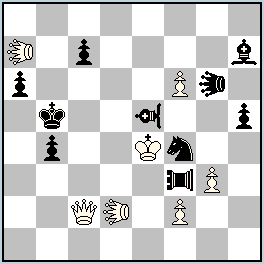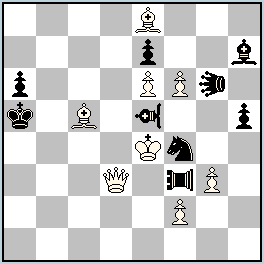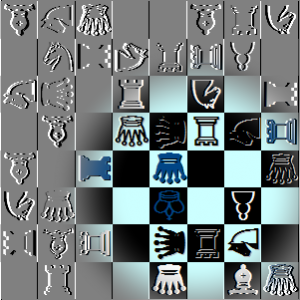|
|
Original Problems (page 88)Original fairy problems published during 2012 will participate in the informal tourney JF-2012. The site is mostly about fairies, but h# and s# are also welcomed for publication! Please send your problems to my e-mail: julia@juliasfairies.com Go to →List of Problems; →Page 87 ; →Page 89 |
No.153 – hs#3 by Nikola Predrag – Excellent play of black batteries! (JV)
No.153.1 – hs#3 by Nikola Predrag – This new version is a big step forward compared to the previous problem, No.153! (JV) I’d like to add that the publication date of this problem, December 16th, is Nikola‘s birthday! Happy Birthday, Nikola! Be the same original and creative, be happy and have fun from everything you do! Many new successes to you!!!
I’d like to add that the publication date of this problem, December 16th, is Nikola‘s birthday! Happy Birthday, Nikola! Be the same original and creative, be happy and have fun from everything you do! Many new successes to you!!!
Definitions:
LEO(LE): Moves as Queen, but captures only by hopping over a hurdle to any square beyond.
Locust (L): moves on Q-lines but only by capturing an enemy unit, arriving on the square immediately beyond that unit, which must be vacant.
Rook-Locust (LR): Moves like Locust, but on Rook-lines only.
Bishop-Locust (LB): Moves like Locust, but on Bishop-lines only.
|
No.153 Nikola Predrag
Croatia
original-16.10.2012
 hs#3 2 solutions (7+10)
LEOs: a7, g6, d2
Bishop-Locust e5
Rook-Locust f3
Solutions: (click to show/hide)
|
No.153.1 Nikola Predrag
Croatia
original-16.12.2012
 hs#3 2 solutions (8+9)
LEO g6
Bishop-Locust e5
Rook-Locust f3
Solutions: (click to show/hide)
|
The diagrams are made on WinChloe and its Echecs font is used for Logo design



Another nice interpretation of the Locust specific Dentist effects from Nikola Predrag. (See nos. 33, 35). Here it is much more complex with nice dual avoidance play on W1 move ! It is far from obvious as to why the other white Leo cannot make the first move. Note also the indirect battery h7/g6) opening differently in each solution. I like it very much. Well done Nikola !!
No.153 Nikola Predrag
An excellent problem which demonstrates the strange power of Locust as battery-pieces! Here the combination with Leos is also very interesting and fruitful. Bravo, Nikola!
Thanks for nice comments.
Yes, it is a continuation of Nos.33&35, essentially encouraged through mentoring by Mr. Petkov.
Of course, Julia is always a good fairy giving a precious support when the things don’t look very promising.
There were some comments and examples for the improvement of No.35 , perhaps I’ll try to write shortly about the later development with intensified thematic play on the Dentist-line.
Nikola, thanks!! I couldn’t be that “good fairy” without a support of all of you, dear authors and visitors!
About your problem.. It looked promising for me from the very beginning! All the versions you’ve sent me. I liked your idea and I wanted it to be finished, to be presented. I’m happy for you! And happy to publish it.
I believe, that all of us will appreciate your comment and examples! Maybe we could discuss here some of your versions if you show them?
Dear Julia, many thanks for so nice wishes!
I would not say that the version is an improvement of No.153. As I mentioned in the comment, the two versions highliht the specific fairy combination by different means.
This means should make the whole idea convincing. Therefore, the answer to “Which version is better?”, certainly depends on personal impression.
Here are two questions about economy. First one is obviously answered in most serious tourneys, but in my composing, I simply can not accept the pieces which have no function in the end, which is sometimes a painful handicap for me.
In these 2 versions, my intention was not to construct the tries to enrich the content. They are just a tool to emphasize that black Leo is needed in the mates for anti-pin and not just a black piece which after playing the mating move (firing battery) can be removed from the board.
(I struggled enough for that in Nos.33&35)
In Nos.153&153.1, the greatest trouble was to find a white piece(s) which could interfere on e3/d4, but also have some other convincing function. White Leos in No.153 play actively and thematically, each in one phase, their presence seems enough convincing.
wBc5 in No.153.1 is a static flights-guarding piece but I hope it is acceptable for O/D refutations of pseudo-thematic tries which underline that complete play in each phase must happen on the same line.
The second question here is the presence of the tries in a hs# which after some helpplay ends as s#1. Thematic tries in that final part might be accepted as a legitimate virtual part of the “authors solution” and thus worth some extra material (wBe8 is here essentially needed only for the tries).
The tries in No.526 begin immediately as 1st white move but the point takes place only in the end .
Anyway, hs# is not only a helpplay and some kind of tries might have a full right of existence which includes also the adequate criteria of economy.